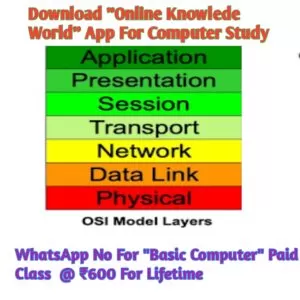7 Layer OSI MODEL
OSI MODEL
Introduction
OSI MODEL1984 में विकसित हुआ। TCP/IP मॉडल के कुछ Limitations को इस मॉडल के द्वारा दूर किया गया। TCP/IP मॉडल में 4 Layer होते हैं जबकि OSI Model में कुल 7 Layer होते हैं। इसका फूल फॉर्म Open System Interconnection है जिसे ISO (International Organization For Standardization) द्वारा विकसित किया गया है। यह एक Reference Model (Conceptual Model) है। इसे Pravtically Implement करना संभव नहीं।
Note:- ISO की स्थापना 1947 में हुई थी। इसका मुख्यालय स्विट्जरलैंड के जेनेवा में अवस्थित है। यह उत्पादों को अंतरराष्ट्रीय मानकीकरण प्रदान करता है।

History Of Development Of OSI MODEL
दुनिया में सबसे पहला नेटवर्क ARPANET बनी 1969 में। 1970 में ARPANET के लिए TCP/IP प्रोटोकोल बनाया गया। 1983 में TCP/IP को Standard Protocol For ARPANET घोषित किया गया। इसलिए 1 जनवरी 1983 को इंटरनेट का Official Birthday घोषित किया गया। इस प्रोटोकॉल में कुछ Limitation थी जिस को दूर करने के लिए 1984 में OSI मॉडल बनाया गया।
Nemonics to Rember 7 Layer
Trick:- Aaj Phir Se Test Nahi Dena Padega
Application Layer (7th) ▶️ Presentation Layer ▶️ Session Layer ▶️ Transport Layer ▶️ Network Layer ▶️ Data Link Layer ▶️ Physical Layer
Hardware Layer
Physical layer (1st Layer) , Data Link layer और Network layer को सम्मिलित रूप से Hardware layer कहा जाता है।
Physical Layer
📚 The physical layer is the first and bottom most layer of the OSI model.
📚 It mainly provides the bit stream transmission (unstructured data stream)
📚 This layer provides interface between the device and the transmission media. Physical layer is responsible for transmitting and receiving data over a transmission media.
📚 This layer provides actual physical connection of device on network through coaxial cable , Optical fibre cables, copper wire etc.
Medium – It Wired/Wireless
Topology – Mess/Star/Ring/Hybrid
Transmission Mode – Simplex/Half Duplex/Full Duplex
Data Link layer
इस Layer को दो भागों में विभाजित किया जाता है ऊपरी भाग को Logical Link Control Layer (LLC) तथा निचले भाग को Medium Access Control Layer (MAC) कहा जाता है।
Function:-
📚 Error Detection
📚 Error Correction
📚 Physical Addressing ( MAC Address) ( Source MAC to Destination MAC)
📚 Framing & Link Address
📚 Reliable Delivery (Node to Node Delivery)
📚 Flow Control
📚 Half duplex & full duplex transmission
,📚 Hop to hop connectivity
Network Layer
📚 Logical Addressing (IP ADDRESS) ( Source IP to Destination IP)
📚 Packet Delivery
📚 Switching & Routing (Path Determination)
📚 Host to host connectivity
📚 Fregmentation
Heart of OSI
Transportation Layer को Heart Of OSI कहा जाता है।
👍 Segmentation
👍 Mutiplexing & Demultiplxing
👍 Point to point Connection
👍 End to End Connectivity
👍 Error Recovery
👍 Acknowledgement
👍 Flow Control
Software Layer
Session, Presentation और Application layer को सम्मिलित रूप से Software layer कहा जाता है।
Session Layer
📚 Connection Create, Manage & Close
📚 Mail Sent Successfully Message (Feedback)
📚 Checkpointing
📚 Authuntication & Authorization
📚 Synchronisation
Presentation Layer
📚 Translation
📚 Compression
📚 Encryption/Decryption
Application Layer
📚 File Transfer, Access & Management
📚 Mail service – Email Forwarding & storage
📚 Used for converting domain name into IP Address.
📚 Network Virtual Terminal – this layer allows a user to log on remote host.
📚 Directory Service – This Layer allows access for global information about various service.
Peer to Peer Connection
Physical – Bits
Data Link – Frames
Network Layer – Packet
Transport Layer – Segment
Session, Presentation, Application – Data
Device Used in Different Layer
Physical Layer – Hub, Repeater, Cable, Modem
Data Link Layer- Switch, Bridge, NIC (Network Interface Card)
Network Layer – Router, Broster (Bridge Router)
Transport Layer – Gateway, Firewall
Session, Presentation, Application Layer-Gateway
Hub – Hub एक नेटवर्किंग डिवाइस है जिसका उपयोग कई कंप्यूटर्स को एक नेटवर्क में जोड़ने के लिए किया b है। इसमें Half duplex Transmission Mode प्रयोग किया जाता है।
Address Used
Physical Layer – None
Data Link Layer- Physical Address (MAC ADDRESS)
Network – Logical Address (IP Address)
Transport Address – Port Address
Session – None
Presentation – None
Application – Application Specific Address
Protocol Used
Physical Layer
✍️ Ethernet
✍️ Wi-Fi
✍️WLAN (IEEE 802.11)
✍️USB
✍️ Bluetooth ✍️✍️✍️
Data Link Layer
✍️ARP (Address Resolution Protocol)
✍️ CDP (Cisco Discovery Protocol)
✍️ STP (Spanning Tree Protocol)
✍️ ATM (Asynchronous Transfer Mode)
✍️ Frame Relay
✍️Ethernet
✍️ SLIP (Serial Line Internet Protocol)
✍️ FDDI (Fibre Distribution Data Interface)
✍️ PPP (Point to Point Protocol)
✍️ PPTP (Point to Point Tunneling Protocol)
✍️ L2TP (Layer 2 Tunneling Protocol) this is extention of PPTP
✍️ IEEE 802.11(WiFi)
✍️ WIMAX (Worldwide Interoperability for Microwave Access)
Note:- Ethernet, WiFi & WIMAX belongs to both layer (Physical & Data Link Layer)
Note:- MAC Address belongs to Data Link Layer
Note:- VLAN (pVirtual Local Area Network) Works in Data Link Layer
Note:- Token Ring works on Data Link Layer
NETWORK LAYER
✍️ IP (IPv4, IPv6)
✍️IPSec (Internet Protocol Security)
✍️ ICMP (Internet Control Message Protocol)
✍️ IGMP(Internet Group Management Protocol)
✍️ IGRP (Internet Gateway Routing Protocol)
TRANSPORT LAYER
✍️ TCP (Transmission Control Protocol)
✍️ UDP (User Datagram Protocol)
✍️ ECN (Explicit Congestion Notification)
✍️ DCCP (Datagram Congestion Control Protocol)
✍️ SCTP (Stream Control Transmission Protocol)
SESSION LAYER
✍️ NFS (Network File System)
✍️ SQL (Structured Query Language)
✍️PAP (Password Authentication Protocol)
Presentation Layer
✍️ SSLP (Secure Socket Layer Protocol)
✍️ TLS (Transport Layer Security)
✍️ MIME (Multipurpose Internet Mail Extension)
✍️ (ASCII (American Standard Code for Information Interchange)
MPEG (Moving Picture Experts Group)
JPEG(Joint Photographic Experts Group)
PNG (Portable Network Graphics)
MP3
✍️ SSH (Secure Shell)
APPLICATION LAYER
✍️ HTTP (Hypertext Transfer Protocol)
✍️ FTP (File Transfer Protocol)
✍️ SMTP (Simple Mail Transfer Protocol)
✍️DHCP (Dynamic Host Configuration Protocol)
✍️ DNS (Domain Name System)
✍️ POP3 (Post Office Protocol)
✍️ Telnet (Teletype Network Protocol)
About Computer Paid Course

